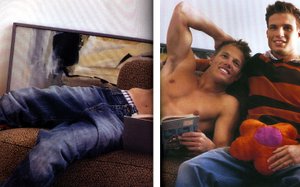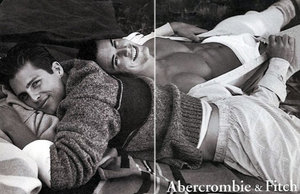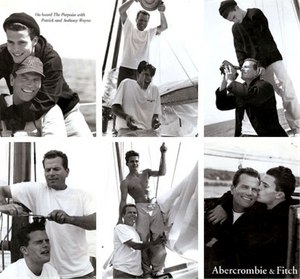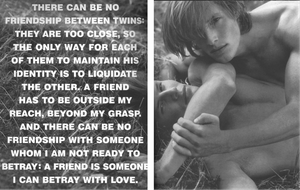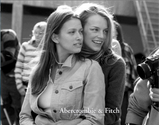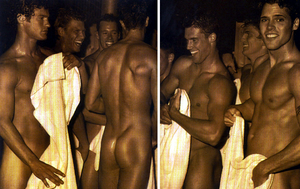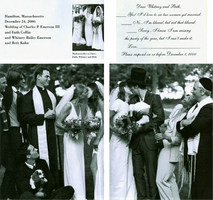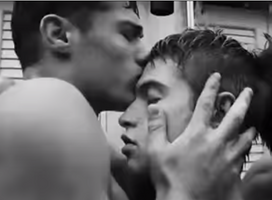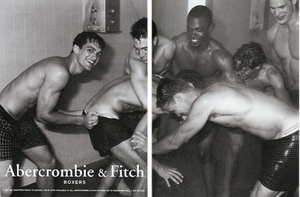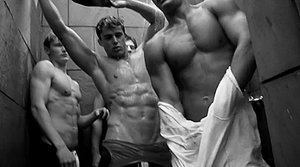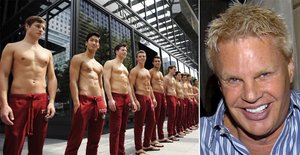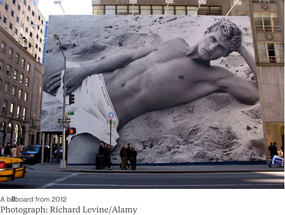Click on pictures for larger image.
Marketing the Rainbow
Successful gay marketing, est. 1892
Arguably one of the most successful brands that crossed over from ‘gay’ to mainstream via a launch in the gay market. Or rather: after a (re)launch in the gay market.
Abercrombie & Fitch, also known as A&F (with sub brands Abercrombie kids, Hollister Co., and Gilly Hicks, and until 2010 Ruehl No.925) was originally founded in 1892 in New York, as an elite outfitter of sporting and excursion goods, particularly noted for its expensive shotguns, fishing rods, and tents.
It filed for Chapter 11 bankruptcy, finally closing its flagship Manhattan store in 1977, but the name was revived shortly thereafter, when in 1978 Oshman's Sporting Goods, a Houston-based chain, bought the defunct firm's name and mailing list. Oshman's relaunched A&F as a mail-order retailer specializing in hunting wear and novelty items.
In 1988, Oshman's sold the company name and operations to The Limited, a clothing-chain operator based in Columbus, Ohio.
The current version of A&F sells mostly clothes for the youth market, and describes its retailing niche as an aspirational "Casual Luxury" lifestyle brand.
Beefcake
With nonstop pictures of beefcake, clothing retailer Abercrombie & Fitch has not only taken the gay community by storm but straight young men in college as well.
The company's black & white magazine ads feature young men streaking through campus, in the showers pulling down others' boxers and fully nude posteriors on the beach (see below).
One insert to Vanity Fair showed a middle-aged man and young man in playful, romantic poses aboard a sailboat, an ad that many read as a gay couple -- even though in reality they were the son and grandson of actor John Wayne.
Although their advertising appeared in OUT magazine over the years, A&F spokesman Hampton Carney said the company doesn't target the gay market. "We really market to 18-22 year old college students," he said.
The company has never feared that its advertising appeared too gay, Carney said. He then added, "It's a shame almost, that it's been pigeonholed as homoerotic."
How to explain these ads?
Yet, with pictures like these, it is hard to believe that “the gay consumer” was not taken into consideration.
Two naked ‘hugging’ teens in an ad were explained as “twins”.
Hugging girls were not even ‘explained’.
These naked guys are drying off from the shower and having a fun time together, as at least one fellow apparently has a wandering eye. This image lacking any actual clothing, as many A&F ads do, is from the Fall 2002 issue of A&F Quarterly, the company's own "magalogue."
A group of guys (and a few girls) are enthusiastically watching and helping another guy strip down to his A&F underwear, in the Fall 2002 issue of A&F Quarterly.
Same-sex wedding
The most overtly gay-specific that Abercrombie has ever done was an image from the Winter 2000 issue of A&F Quarterly, depicting a double wedding of the Emerson family. Ironically, the reply card responses include "No... I'm liberal, but not that liberal" and "Yes... I'd love to see two women get married."
For a number of years, the successful quarterly magalogue and ongoing ad campaigns were created by celebrity art photographer Bruce Weber and Sam Shahid, creative director of Shahid & Co., New York.
Openly gay Shahid said that Abercrombie has never been concerned about his work appearing too gay. Yet like A&F, he is uncomfortable talking about the advertising in terms of its appeal to the gay market. He focuses on its universal appeal, noting that heterosexuals love the advertising as much as gays.
Gay vague
The ads for A&F, with uncommon displays of male physical interaction, strike many as gay vague too. Shahid describes such model interactions as uncoached, that their physical antics are mostly spontaneous. "There's a freedom there, they don't have any problem touching one another. We as adults have a problem when we're looking at it and read things into it."
Finally, in 2012 they went an extra step by featuring a kiss between two shirtless hunks in the showers. Shot by famed photographer Bruce Weber, the steamy clip depicts a number of male models wrestling each other to the ground and in the shower before the smooch, which is actually quite tame compared to some of the more provocative poses struck by the men throughout the video. Titled "Other Sports Require One Ball, Wrestling Requires Two," the video is one of four wrestling "Webersodes" to be found on Weber's official website: Everything Else In Life Seems Easy, Basketball Is What Boys Do, Live Eat And Sleep Wrestling. The men in the videos wear A&F garments, but these do not play a prominent role.
An Abercrombie & Fitch representative said that the four videos were not part of any official advertising campaign, despite the fact that Weber's Facebook page identified them otherwise.
Softcore megalogue
Yet, sources like Brandweek observed: “Abercrombie & Fitch kept a straight face while publishing a gay softcore "quarterly" for years.”
The magalogue has brought some trouble to A&F, for its occasional male nudity (shrink wrapping coupled with an age disclaimer were added magalogue in 1998).
It was also the magalogue that created a big gay following: a ‘brochure’ filled with hunks and interesting men has easily won over many gays. This lead to A&F items being worn at gay social functions, thus spreading its popularity further.
Many gays were upset when an article in New York magazine about the American version of controversial Brit hit "Queer As Folk" pointed out that the retailer would not allow product placements in the show: A&F said it never loans product for placements.
The legacy of CEO Mike Jeffries
Throughout his 20 years as the leader of the Abercrombie brand, CEO Mike Jeffries has acknowledged the company’s intention to sexualize its marketing, and adamantly denied that there is anything inappropriate about it. "I think that what we represent sexually is healthy. It's playful. It's not dark. It's not degrading! And it's not gay, and it's not straight, and it's not black, and it's not white. It's not about any labels. That would be cynical, and we're not cynical! It's all depicting this wonderful camaraderie, friendship, and playfulness that exist in this generation and, candidly, does not exist in the older generation."
Jeffries completely re-vamped the company with his signature homoerotic ads and the shirtless greeters in (or actually outside) the stores. However, his obsession with beauty and youth seemed to get the best of him. Jeffries fell under fire after critiquing over-weight customers and even got slammed with an anti-age lawsuit from the male models who worked on his private jet.
Late 2014 70-year-old Jeffries, once one of the highest-paid CEOs, resigned “following a drop in sales”. Earlier that year, Abercrombie removed Jeffries from his chairman position in response to pressure from an investing company. Investors seem to be enjoying Jeffries' departure so far with stocks on the rise, up about 7.5 percent at publication. His departure was also an excuse for the gay press to review his legacy, for instance out.com with “21 Gayest Abercrombie & Fitch Moments”.
© 2022 BRIGHT Marketing Solutions
Case study: Abercrombie & Fitch
Branche: Fashion

